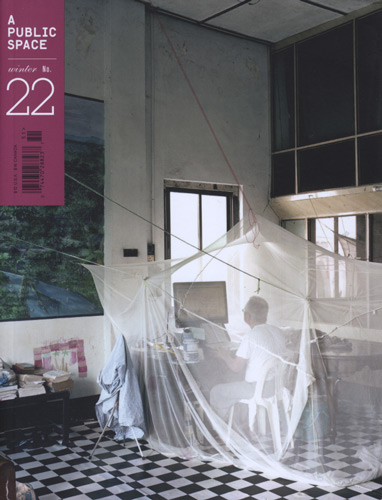A Public Space – Winter 2015
A Public Space fits neatly into my hands with its fine matte finish and folded flaps for bookmarks (in case there are no café receipts handy). The shade of magenta coordinates warmly with Lee Satkowski’s photograph—a writer in his studio, mosquito net surrounding his workspace, 50s checkered tile below his feet—providing a vibe that one would find in a coffee shop in Williamsburg. Its cream-colored pages are easy on the eyes, making it an ideal read under the sun or florescent lighting. Although designed with an aesthetic I am partial to, A Public Space provides content that fits neatly into your palms, but untidily in memory. A Public Space fits neatly into my hands with its fine matte finish and folded flaps for bookmarks (in case there are no café receipts handy). The shade of magenta coordinates warmly with Lee Satkowski’s photograph—a writer in his studio, mosquito net surrounding his workspace, 50s checkered tile below his feet—providing a vibe that one would find in a coffee shop in Williamsburg. Its cream-colored pages are easy on the eyes, making it an ideal read under the sun or florescent lighting. Although designed with an aesthetic I am partial to, A Public Space provides content that fits neatly into your palms, but untidily in memory.
The reader must navigate through the issue without the guidance of an editor. Initially, there was some reluctance, as I am the type of reader that prefers to know what will pop out of the jack-in-the-box after a few cranks. However hesitant, the magazine pulled me in, feet-first, with Kelly Link’s, “The New Boyfriend,” a surrealistic-paranormal, young adult narrative where tangible objects provide intangible feelings, or in other words, where young girls fall in love with life-sized dolls. Link’s narrative differentiates itself from the young adult classic, Twilight, with a cast of believable, teenage characters who naively traverse through friendship and fantastical romance blunders with vampires, werewolves, and ghosts. After reading about a world where “[g]hosts exist and the world is magic and there is an unreal boy whose name she doesn’t even know [ . . . ],” you will be dying to find a real romance of your own.
Photographs correlate well with each narrative in A Public Space, and provide a sense of closure to each piece; where one world ends a new image emerges with a story behind to follow. Yet, not every narrative in the magazine touches on the uncanny. Like the title of the journal suggests, this publication encompasses what one could find on street corner—a collection of stories poignant, weird, or philosophical, both long and short. It also features delectably translated fiction, as well as poetry.
At the heart of A Public Space resides a sequence of poems, none more elegant than Kimiko Hahn’s, “Extant”—physically disjointed, but emotionally intact. Hahn opens powerfully with, “I am not gigantic,” suggesting that while something exists, be it an animal or human, it may never know the infamy of extinction solely because of its size.
Towards the back of the magazine resides Julia Cooke’s essay, “The Art of Participation” which recounts the works and findings of Pablo Helguera. Attached to the essay is a personal photo of a letter Cooke received from Helguera, which is as profound as Cooke’s own perceptiveness. In her essay, she describes her personal exchanges with Helguera during The Parable Conference era in which Helguera seeks to understand how art is perceived. As a reader, I began to question my own perceptions of art, and came away from Cooke’s essay with this: “To be fully seen, period, is powerful; to feel seen by another person in something that calls itself a work of art is ever more so.”
“The Messiah,” by Prawin Adhikari, ends the collection with a discouraging epiphany. Set in Nepal, a man struggles with learning that a village’s savior, who saved his life by donating his blood, “[ . . . ] had been ordinary, even more so than me.” The revelation of his mistaken identity leaves the protagonist more dead inside than he was before the transfusion.
Many private lives of characters become our own in A Public Space. We are the doll, the gynecologist, the invisible existence, the philosopher, victim, and messiah all at once with each turn of the page.
[www.apublicspace.org]





